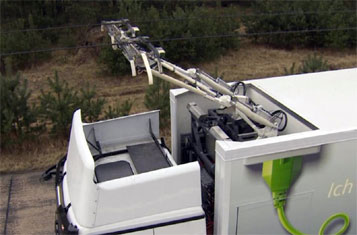We often see trucks barrelling down highways, but Siemens has a different vision.
It sees trucks attached to overhead electric trolley-like wires traveling peacefully down an "eHighway" in a separate lane.
"When most people think of vehicle emissions, they assume cars do most of the damage, but it’s actually commercial trucks that are largely to blame," says Daryl Dulaney, CEO, Siemens Infrastructure & Cities, United States. "Freight transportation on U.S. roadways is expected to double by 2050, while global oil resources continue to deplete. And by 2030, carbon dioxide emissions are forecasted to jump 30 percent due to freight transport alone."
Besides the benefits of reduced fossil fuel use and emissions, and reduced pollutant load in residential and agricultural areas, the system is easy to integrate into existing highways and infrastructures. Trucks will also be much quieter.
The only downside is cost – Siemens estimates the system will cost $5 million to $7 million per mile to build.

Siemens has developed the supporting technology necessary to make the eHighway a reality – infrastructure, software, hardware and drives.
Essentially, what’s needed is a hybrid-diesel electric freight truck with built-in technology and software to connect to overhead electrified wires.
When trucks detect and attach to overhead wires they automatically go into electric mode, and when they detach they automatically switch back to diesel. Pretty cool.
Siemens will apply its ELFA hybrid drive system which enables vehicles to switch between an internal combustion engine and electricity. Even when the trucks are in hybrid diesel mode they consume 30% less fuel.
Siemens says as the technology becomes more widely adopted, every truck equipped with an electric drive system will be able to use the eHighway: diesel electric, pure battery, fuel cell range extended or natural gas.
Based on a pilot project in Germany, trucks can make the switch at speeds of up to 90 kilometers/hour.
Pilot eHighway Planned
Pilot ehighway projects are in the planning stages from the Ports of Los Angeles and Long Beach traveling inland along I-710.
There are severe air pollution and related health problems in the vicinity because of the more than 10,000 trucks that serve the two ports, in addition to trains, ships and heavy equipment.
The South Coast Air Quality Management District (AQMD) can’t meet federal air quality standards without moving to zero- and near-zero-emission trucks and cars.
"The ports have made tremendous improvements, but goods-movement-related air pollution remains our largest source of air pollution in Southern California," Barry Wallerstein, AQMD executive officer told the LA Times. "We’re hopeful we’ll get the eHighway off the ground in the next 12 months. He’s working on getting grants from the U.S. Department of Energy to build it.
AQMD is also running pilots of zero-emission electric and fuel cell trucks at the Port of LA.
Another idea is a Green Marine Highway, where the freight from trucks would be moved to fuel-efficient ships on the Atlantic and Pacific Coasts.
Earlier this month, the Port of LA approved an Environmental Ship Index program that goes into effect July 1. It rewards ocean carriers for bringing their newest, most efficient vessels to the Port.

 Loading...
Loading...
This is proven techology that has been in use for over 100 years. The weak link in electric vehicle technology is the battery … still waiting for a good one …
Similar technology is used in open pit mining operations; they use enormous trucks. Electric trolley buses are used worldwide.
No reason a hybird car couldn’t spout trolley poles and go along for the ride!
I wonder why is that no one attempted to put rail on electricity, as it is done all over the world. You are trying to make trucks run on electricity… on the highway. you have highways 4-5 and more lines. This is probably the most insane idea I have the luck to hear. Trolley bus is outdated system as it lack flexibility in the path used to get from point A to point B. If you wish to do something… Electrify the railroads… they are inflexible, carry much more cargo (use more fuel then a truck) and is a proven technology all over the world. Question is how will you convince UP or BNSF.. to convert to electricity and spend huge amount of money on electricity distributing system…
I agree that this concept looks strange. I sent my concept of Global Intelligent Transportation System to Siemens on 12/12/2010. Compare both concepts.
http://www.global-its.org/gitsforum.htm